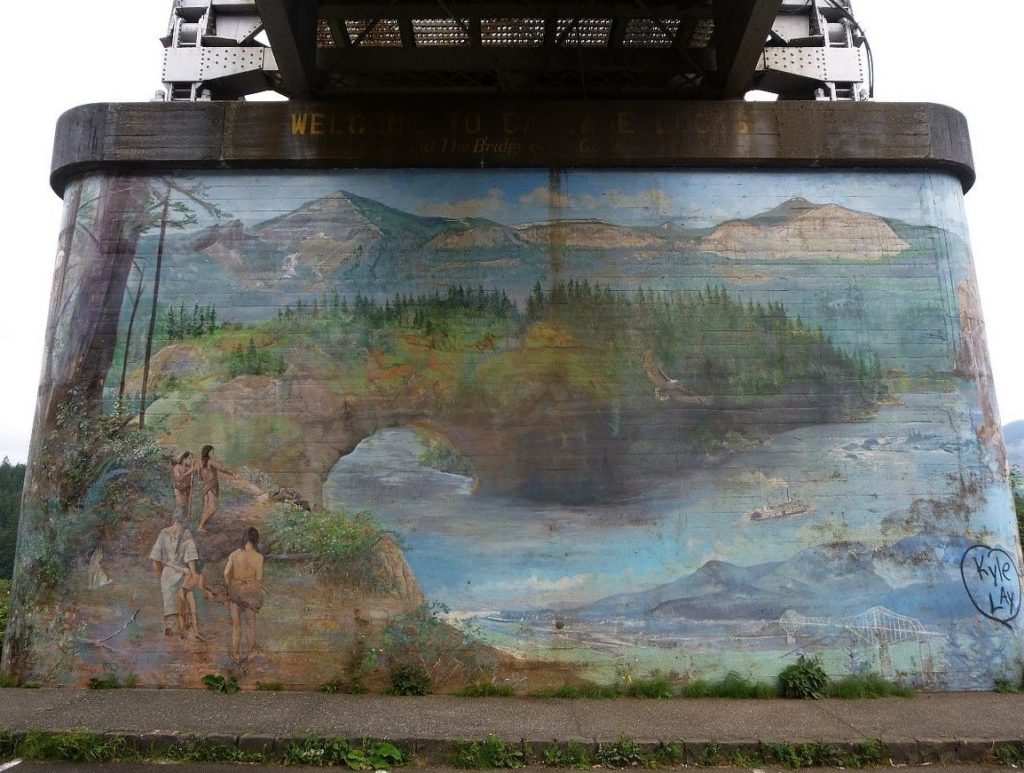The Bridge of the Gods
By Alice Winship
The old ones tell a story that comes rollin’ down the years
From where the blue Columbia sings songs the coyote hears.
In the misty past, the mountains fell, a roar came from the slide.
A crashing fall of boulders filled the gorge from side to side.
Chorus: The Bridge of the Gods, a gift, A mighty span of stone.
Dry-shod, the people trod the rift Where once the water shone.
Friends could cross to visit, from north and south, they say.
But if brothers fight, the bridge will fall, don’t throw the gift away
Wyeast was a singer; his name is now Mount Hood.
Up north where lovely Loowit lived, her lofty mountain stood.
Where the trees are green, the snowcaps gleam, Mount Adams came in view;
This other brother Pahto loved the fair St. Helens too.
The brothers took to fighting, so fast their anger came
Their words were burning rocks they threw; they set the woods aflame.
They shook the ground, the rocks rained down; the bridge broke up and fell.
The rocks caused Cascade Rapids with the waters’ crash and swell.
Notes
A modern steel bridge called The Bridge of the Gods spans the Columbia River about 40 miles east of Portland, about 4 miles upriver from Bonneville Dam. It takes its name from a natural dam made when a landslide blocked the Columbia River. The event is remembered in Native American legend.
Geologists confirm that a landslide did indeed block the Columbia, and people would probably have been able to cross, as the Native American stories tell. The date of the slide, as estimated by radio carbon dating (of submerged and buried trees) and dendrochronology (counting tree rings) is debated by geologists, but has ranged between 1060 and 1760 AD. There may have been several landslides, which would account for the conflicting data. A large lake was formed behind the natural dam, but eventually the dam would have washed away.
Tribes from central Oregon to northern Washington told stories of a stone bridge across the Columbia below The Dalles. These stories have been altered so often in the telling that it is difficult to determine what the native tradition was. The stories seem to have varied with the tribe, and perhaps with the individual storyteller.
One version is that long ago, the mountains were people. Wyeast (Mount Hood) and Pahto (Mount Adams) were brothers, sons of the chief spirit, Manito, who made a bridge to allow people to cross the river to visit. When the people feared the bridge would wash away, they appealed to Manito, who agreed to protect it. The bridge was then renamed the Bridge of the Gods.
But Wyeast and Pahto fell in love with the same woman, Loowit (Mount St. Helens). (Before her 1980 eruption, Mount St. Helens had the most symmetrical and beautiful shape of any Northwest volcano.) In their jealousy and rage, the two brothers began fighting, throwing red-hot boulders at each other. Their fighting shook the ground and set the forests on fire, driving the people into hiding. The fight caused the Bridge of the Gods to fall, its debris forming Cascade Rapids in a place where formerly canoes could pass on smooth water.
Geologists agree that the debris from the landslide formed Cascade Rapids, one of two major former obstructions to navigation on the lower Columbia River. (The other was Celilo Falls and the Dalles.) Cascade Rapids are now submerged underneath the waters behind Bonneville Dam. The mountains looming over the rapids were called ‘the mountains by the Cascades’ and then simply ‘the Cascades’, giving a name to the Cascade Range.
Credit
- Written by: Alice Winship
- Arranged by: Alex Sturbaum
- Alex Sturbaum: lead vocal, harmony vocal, guitars
- Alicia Healy: bass

